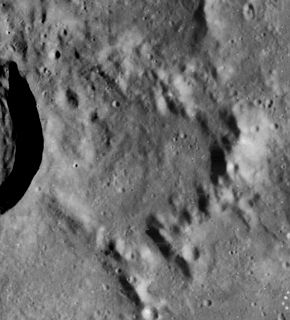This page is based on this
Wikipedia article Text is available under the
CC BY-SA 4.0 license; additional terms may apply.
Images, videos and audio are available under their respective licenses.

In physics and geometry, a catenary is the curve that an idealized hanging chain or cable assumes under its own weight when supported only at its ends.

An electrode is an electrical conductor used to make contact with a nonmetallic part of a circuit. The word was coined by William Whewell at the request of the scientist Michael Faraday from two Greek words: elektron, meaning amber, and hodos, a way.

A scientist is someone who conducts scientific research to advance knowledge in an area of interest.

Tempel is the remnant of a lunar impact crater whose outer rim has been eroded, indented, and reshaped by subsequent impacts and lava flows. It is attached to the eastern rim of the crater Agrippa, in an area that has been resurfaced by old lava flows. To the southwest is Godin, and to the east lies the small, bowl-shaped Whewell. Its diameter is 43 km. The crater was named after German astronomer Wilhelm Tempel.

Cayley is a small lunar impact crater that is located in a lava-flooded region to the west of Mare Tranquillitatis. It was named after the 19th century British mathematician Arthur Cayley. It lies to the northwest of the smaller crater De Morgan and the larger D'Arrest. West and slightly north of Cayley is Whewell, a crater of about the same dimensions. To the north is a linear rille designated Rima Ariadaeus, which follows a course to the east-southeast.
In geometry, an intrinsic equation of a curve is an equation that defines the curve using a relation between the curve's intrinsic properties, that is, properties that do not depend on the location and possibly the orientation of the curve. Therefore an intrinsic equation defines the shape of the curve without specifying its position relative to an arbitrarily defined coordinate system.
Dallam School is a mixed, 11-18 secondary school with academy status, located in Milnthorpe, Cumbria, England.
Hypotheses non fingo is a famous phrase used by Isaac Newton in an essay, "General Scholium", which was appended to the second (1713) edition of the Principia.
Robert Leslie Ellis was an English polymath, remembered principally as a mathematician and editor of the works of Francis Bacon.
In geometry, the Cesàro equation of a plane curve is an equation relating the curvature at a point of the curve to the arc length from the start of the curve to the given point. It may also be given as an equation relating the radius of curvature to arc length. Two congruent curves will have the same Cesàro equation. Cesàro equations are named after Ernesto Cesàro.

In geometry, the tangential angle of a curve in the Cartesian plane, at a specific point, is the angle between the tangent line to the curve at the given point and the x-axis.

Wyresdale Hall is an English country house and licensed wedding venue located within the Forest of Bowland to the northeast of Scorton, Lancashire, England.
Thomas Gaskin (1810–1887) was an English clergyman and academic, now known for contributions to mathematics.








